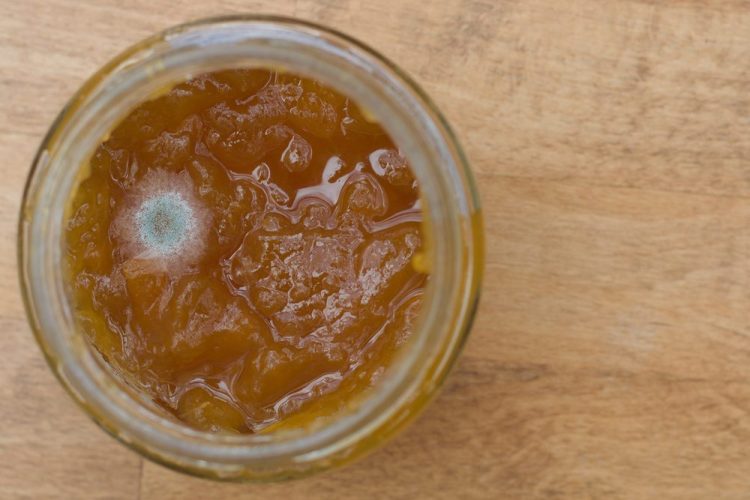Mycotoxins in jam – why Theresa May’s “scrape the mould” method isn’t entirely misguided
Posted: 27 November 2025 | Alexandra Schamann, Rudolf Krska | No comments yet
The debated topic of what to do with mouldy jam was ignited following an off-hand remark from UK Prime Minister Theresa May several years ago. Finding a surprising lack of research on the matter, Alexandra Schamann and Rudolf Krska now share findings from a recent Austrian study that sheds light on the quandary.


In 2019, then-Prime Minister of the UK Theresa May stirred debate during a Cabinet meeting on food waste when she admitted to simply scraping mould off jam and consuming what remained underneath.1 The remark, while intended to highlight a practical approach to waste reduction, provoked concern over the safety of such practices. The central question it raised was how far mycotoxins and other harmful fungal metabolites can spread beyond visible mould in jam?
The safest recommendation remains to discard the entire jar if mould is observed. However, the data suggest that Theresa May’s approach may not have been entirely misguided.”
Surprisingly, scientific literature addressing this everyday food safety concern is limited. The few existing studies have largely focused on mycotoxin migration in apple jam,2,3 with findings indicating that toxins such as patulin can diffuse up to 4cm into the product.2 These studies underscored the need for further investigation, especially considering the prevalence of homemade or artisanal jams with varying sugar contents, pH levels and production standards.
In response to this knowledge gap, researchers from several Austrian institutions, which included the authors of this article, recently conducted a study published in the World Mycotoxin Journal.4 Their goal was to better understand the distribution of fungal secondary metabolites in jars of jam with visible surface mould. The team collected 57 jars of spoiled jam from various producers, all showing signs of contamination likely due to insufficient sterilisation or faulty sealing. The jams spanned common varieties such as apricot, strawberry, raspberry, blueberry and blackberry.
The contaminating fungal strains were isolated and tentatively identified through morphological analysis and DNA sequencing of the internal transcribed spacer (ITS) region. The most frequently encountered species included Penicillium crustosum, Penicillium bialowiezense, Aspergillus niger, Aspergillus versicolor and Penicillium expansum. No direct correlation between fungal species and jam type was found, although species-specific preferences for sugar concentration were noted: for instance, A. niger was detected in jams averaging 33.2 percent sugar, whereas A. versicolor appeared in samples with higher sugar content – 42.2 percent, on average.
The study analysed toxin levels directly at the site of visible mould growth, as well as in jam located 1cm below and 1cm adjacent to the contamination. The toxins were quantified using liquid chromatography-mass spectrometry (LC-MS), applying a method that allows for the identification and quantification of hundreds of mycotoxins and further fungal secondary metabolites. Results showed that while concentrations of most target compounds dropped significantly just 1cm away from the mould, certain secondary metabolites such as nigragillin, mycophenolic acid and viridicatin remained present at notable levels. For example, mycophenolic acid, an immunosuppressant drug with known teratogenic potential,5 was still found at concentrations exceeding 3,000 µg/kg in samples taken just 1cm from the mould. However, previous assessments have not deemed similar levels in food toxicologically significant6 and no acute or chronic toxic effects from nigragillin or viridicatin have been reported, to date, to the best of our knowledge. Additionally, sterigmatocystin, a genotoxic and possibly carcinogenic aflatoxin precursor,7,8 was detected in jams contaminated with A. versicolor.7,8 Fortunately, its migration into surrounding jam was minimal.
To investigate further the migration of fungal secondary metabolites over a greater distance, the researchers inoculated apricot jam, which is one of the most frequently consumed types of jam in Austria, with spores of the three most common fungal species from the first part of their survey – P. crustosum, P. bialowiezense and A. niger. The jars were then incubated at room temperature for 14 days. Concentrations of secondary metabolites were measured in layers at increasing depths from the mould. Most metabolites dropped by over 90 percent at depths of 1–2cm below the mould. Nonetheless, some, like cyclopenol and mycophenolic acid, were still detected in considerable amounts. At 2–4cm depths, levels declined further to below 100 µg/kg.
What does this mean for consumers?
Based on these findings, the study concluded that while most mycotoxins and further fungal secondary metabolites do not migrate far from the visible mould, their presence cannot be entirely ruled out beyond the immediate contamination site. Therefore, the safest recommendation remains to discard the entire jar if mould is observed. However, the data suggest that Theresa May’s approach may not have been entirely misguided. The health risk associated with consuming jam more than 3cm below visible mould appears to be low, considering that most metabolites significantly diminish at these depths. Still, caution is warranted: the study only examined a subset of fungal species and limited incubation time. Broader research, encompassing longer storage periods and more diverse fungal profiles, is necessary to offer definitive safety guidelines. Until then, prevention is the most reliable strategy. Consumers can reduce spoilage risk by using smaller jars, storing opened jars in the refrigerator, consuming contents promptly and avoiding contamination by always using a clean spoon.
Acknowledgements
This work was created within a research project of the Austrian Competence Centre for Feed and Food Quality, Safety and Innovation (FFoQSI). The COMET-K1 competence centre FFoQSI is funded by the Austrian federal ministries BMK, BMDW and the Austrian provinces Lower Austria, Upper Austria and Vienna within the scope of COMET – Competence Centers for Excellent Technologies. The COMET Programme is handled by the Austrian Research Promotion Agency FFG.
References
[1] Doyle J. I scrape mould off the top of jam and eat what’s underneath, admits PM: Theresa May shares hot tip with Cabinet in discussion over food waste. Mail Online 2019. https://www.dailymail.co.uk/news/article-6698171/I-scrape-mould-jam-eat-whats-underneath-admits-PM.html
[2] Olsen M, Gidlund A, Sulyok M. 2017. Experimental mould growth and mycotoxin diffusion in different food items. World Mycotoxin Journal 10: 153-161. https://doi.org/10.3920/WMJ2016.2163
[3] Olsen M, Lindqvist R, Bakeeva A, et al. 2019. Distribution of mycotoxins produced by Penicillium spp. inoculated in apple jam and crème fraiche during chilled storage. International Journal of Food Microbiology 292: 13-20. https://doi.org/10.1016/j.ijfoodmicro.2018.12.003
[4] Schamann A, Caprio A, Krpan M, et al. 2025. Mycotoxin migration in jam samples: a study on natural contamination and experimental inoculation. World Mycotoxin Journal. https://doi.org/10.1163/18750796-bja10028.
[5] Hoeltzenbein M, Elefant E, Vial T, et al. 2012. Teratogenicity of mycophenolate confirmed in a prospective study of the European Network of Teratology Information Services. American Journal of Medical Genetics, Part A 158A:588–596. https://doi.org/10.1002/ajmg.a.35223
[6] Gruber-Dorninger C, Novak B, Nagl V, Berthiller F. 2017. Emerging mycotoxins: beyond traditionally determined food contaminants. Journal of Agricultural and Food Chemistry 65: 7052-7070. https://doi.org/10.1021/acs.jafc.6b03413
[7] International Agency for Research on Cancer (IARC), 1976. Monographs on the evaluation of the carcinogenic risk of chemicals to man: Some naturally occurring substances, 10, Lyon, France
[8] European Food Safety Authority (EFSA), 2013. Scientific opinion on the risk for public and animal health related to the presence of sterigmatocystin in food and feed. EFSA Journal 11: 3254. https://doi.org/10.2903/j.efsa.2013.3254
Meet the authors


Rudolf Krska is Full Professor at BOKU University, where he leads the Institute of Bioanalytics and Agro-Metabolomics in Tulln, Austria. He is also a co-affiliated Prof at Queen’s University Belfast´s Institute for Global Food Security and serves as a key researcher at the Austrian Competence Centre for Feed and Food Quality (FFoQSI). Krska is (co‑)author of >520 SCI papers, which have been cited >25,000 times (h-index: 82, Scopus). In 2024 he received the prestigious €100,000 Nils Foss Excellence Prize in recognition of his pioneering work in food science and analytics.


Alexandra Schamann is a postdoctoral researcher in food safety at the Austrian Competence Centre for Feed and Food Quality, Safety and Innovation (FFoQSI). Her research focuses on the analysis of mycotoxins in various food products. She studied nutritional sciences at the University of Vienna, for which she received the Honorary Prize of the Austrian Federal Ministry of Education, Science and Research. Subsequently, she completed her PhD in microbiology at the German Federal Research Institute of Nutrition and Food in Karlsruhe in 2022.
Related topics
Contaminants, Food Safety, Health & Nutrition, Mycotoxins, Pathogens, Quality analysis & quality control (QA/QC), The consumer, World Food









